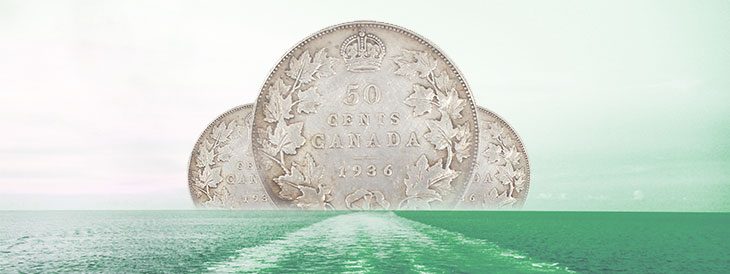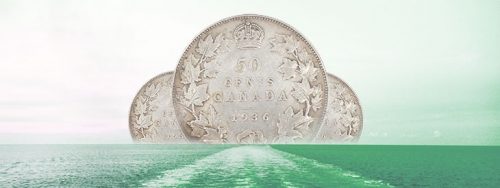Last updated on August 14th, 2025 at 12:25 pm
Last Updated on August 14, 2025 Posted by Colonial Acres Coins
Among coinage that has a long and storied history in Canada, a particularly interesting one is the 50 cent coin. While seemingly strange, this important denomination was actually the highest value coin when it was first introduced by the Dominion of Canada in 1870. The piece represented a significant sum at the time, especially considering that most workers at that time likely earned between $5 and $15 a week. Today’s Canadian 50 cent coin value is highest among collectors, especially since it is no longer minted for circulation. It existed in 5 separate series:
1870-1901
Also referred to as Victorian coins, these were minted in 92.5% sterling silver – standard at the time for the British Empire. It had an impressive size and weight, with equally impressive design features. The obverse depicts a crowned bust of Queen Victoria with the inscription “Victoria Dei Gratia Regina Canada,” which translates into “Victoria Grace Of God Queen Of Canada.” The reverse side shows St. Edward’s crown on top of two rows of maple leaves with a ribbon on the bottom.
1902-1910
Otherwise known as the early 20th century Edward VII dates, these coins were minted in a style very similar to the Victorian issues. Naturally, the obverse shows a change of bust of the monarch. There were actually coins produced for every year of Edward’s reign, unlike during the 1800s. Among particularly difficult coins to locate are 1904 and 1905 issues, even in used condition.
1911-1936
The George V 50 cent coins saw a reduction in silver content from 92.5% to 80% in 1920, all the while keeping with the same design. Over a million were made annually by 1919, in addition to the mintages being greatly increased during World War I. Interestingly, almost all of the 1921 and much of the 1920 dates were held back from circulation and eventually melted. This was because there were so many 50 cent pieces around by the early 1920s. In fact, as little as 75 to 100, 1921 50 cent coins are known to have survived, which drove up their price to between $20,000 and $250,000, depending on the condition. This is why the 1921 Canadian 50 cent coin was nicknamed “King” of Canadian coins.
1937-1952
The George VI issues saw a complete design change. The bust of the king or queen had no crown on top for the first time. Conversely, only a Canadian coat of arms can be seen on the reverse. Particularly interesting is one of the four basic varieties of the 1947 coins. There are two types of 7’s in the date – one with the tip of the 7 facing left and another where the tip is curved right. Additionally, some of the 1947 coins were also minted with a small maple leaf after the date. The coins with a curved 7 and a maple leaf after the date are the rarest combination and represent a classic Canadian rarity. So much so that they are valued in the thousands of dollars even in used condition.
1953-Present
Elizabeth coins continued the tradition of Her Majesty’s father and do not show a crown on her portrait. Until 1967, 50 cent coins continued to be issued in 80% silver. Because it was the 100th anniversary of the Confederation, the 1967 date was special and featured Canadian animals on all denominations. An image of a howling wolf was struck for the 50 cent. Between 1968 and 2000, 50 cent pieces were struck in pure nickel. Between 2000 and end of production in 2003, they were made from plated steel.
Looking For More Interesting Canadian Coins? Head Down To Colonial Acres
Colonial Acres Coins is home to an expert and professional team of highly skilled numismatists, welcoming both beginner and seasoned coin collectors. It is THE resource for anyone interested in old paper money and valuable coin pieces, including those who would like to know more about the Canadian 50 cent coin value. Rest assured that you’ll find everything you need at Colonial Acres, so get in touch with them today and enrich your collection with some rare pieces.




